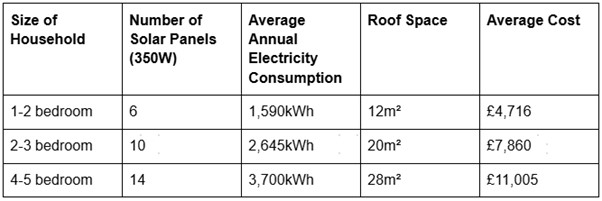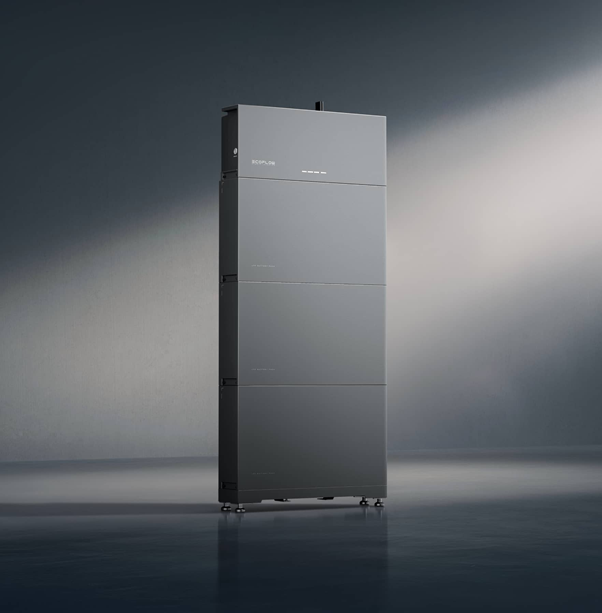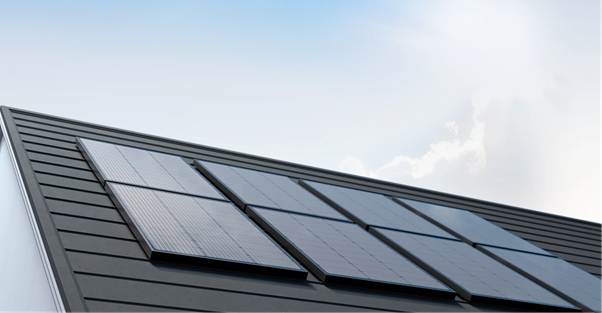How Many Solar Panels Are Needed to Power a House?
Switching to solar energy is a great way to cut electricity costs and reduce your carbon footprint. But how many solar panels do you actually need to power your home? The answer depends on your household size, electricity consumption, roof space and orientation, panel efficiency and rated power, location, and peak sunlight hours. A three-bedroom house with average energy use in the UK requires around 10 panels (350W each). This guide will walk you through everything you need to know to calculate the correct number of solar panels, also called photovoltaics, for your home.
How Many Solar Panels Do I Need to Power My House?

Electricity Consumption
Your electricity consumption depends on the size of your home, the number of people living there, and what kinds of appliances you have. According to Ofgem, the average home in the UK uses 2,700kWh annually. The larger the house, the more people, and the more appliances, the more power you will use. You can find your kWh consumption on your monthly electrical bill. Grid-tied systems will significantly lower your electrical bill because they reduce the amount of energy you need to draw from the grid.
Sun Hours
Another factor that affects how many photovoltaics you need is the number of peak sunlight hours you have. This is when the sun is directly overhead, and photovoltaics operate at peak efficiency. In the UK, peak sunlight hours vary from 3.2 in Northern Ireland and 3.3 in Wales to 3.7 in Scotland and 4.1 in England. This means those in England and Scotland will need fewer panels to meet their energy needs than those in Wales or Northern Ireland.
Rated Power
The rated power of your panel determines how much it can produce under ideal conditions and will play a role in how many photovoltaics you need. For instance, buying 200W models will require about twice as many as purchasing 400W ones.
To estimate how many kWh your panel might produce, multiply the rated power by your peak sunlight hours. If you have a 400W panel and you have 4.1 peak sunlight hours, then, in theory, you can produce:
400W x 4.1 peak sunlight hours = 1640Wh daily
However, that’s under ideal conditions—and of course, conditions in the real world are rarely perfect. For this reason, it’s often recommended that the output be multiplied by 75%. In this case:
400W x 4.1h x 0.75 = 1230Wh daily
Therefore, you can safely assume your 400W photovoltaic will produce at least 1230Wh daily, knowing it has the potential to create more.
Panel Efficiency
Not all photovoltaics are created equal. Thin film models are only about 6 to 13% efficient, while polycrystalline models are generally in the 16 to 19% range. High-quality monocrystalline models offer the best conversion efficiency at up to 23%. The lower the conversion efficiency, the more panels you need and the more space it takes up. This is why monocrystalline is always recommended, especially when space is limited.
Roof Orientation
Almost all homes are suitable for solar energy. Still, roof orientation significantly affects how much energy you can produce. If you have a large roof facing south with a slight tilt toward the west, with no large trees or other buildings shading it, these will perform best in the UK. Those facing east and west are the next best option, while north-facing roofs are generally not recommended.
The other factor to consider is the angle. The optimum angle for photovoltaics in the UK is between 30° and 50°. To get the most out of your system, it's a good idea to design it so that you can adjust the angle throughout the year. For instance, using a lower angle (30°) in the summer and adjusting to a steeper 50° angle in the winter will maximise your direct sunlight.
Size and Suitability of Roof
Sometimes, people think you can’t install solar on a flat roof. However, if your roof is flat, you can still use photovoltaics. In fact, flat roofs make it even easier to install and position them. It’s much easier to deal with shade and obstructions since you can place them anywhere on the roof at any orientation and angle to optimise your system. You simply need additional mounting brackets like those used for a ground-mounted system.
However, if your roof is too old, you should upgrade it before installing photovoltaics. You can also install ground-mounted systems in your yard or garden or install some on a shed or carport roof.
When considering roof size, remember it's not just the total size of your roof that matters. Any shade will significantly reduce your overall output; therefore, it’s best to consider usable space rather than total space when looking at roof size. As a rule of thumb, each solar panel will typically take up just under 2m² of space. So, if you need 10 panels to meet your energy needs, you will need about 20m² of usable space.
On-Grid vs Off-Grid
Finally, the other factor is deciding whether to stay on-grid or go off-grid. With on-grid solar, you must decide how much of your grid power you want to supplement with solar. For off-grid systems, you need enough photovoltaics to meet your energy needs.

How To Calculate How Many Solar Panels You Need
1. Calculate Annual Electricity Usage
The first step is to determine how much electricity you use each year. Luckily, this information is easy to find by looking at your monthly power bills, which you can usually find online. Otherwise, if you can’t find your bills, contact your supplier and ask them for your total yearly kilowatt-hours (kWh). On average, a three-bedroom house in the UK uses 2,700kWh per year. Depending on the size of your home, how many people live there, and what kinds of appliances you have, yours could be more or less than that.
2. Decide What Size Panel to Use
On average, a typical 350W solar panel will produce about 265kWh per year in the UK. While that number varies with the rated power, manufacturer, and local conditions, you can use it as a rough estimate of how many panels you need. Simply divide your annual usage by 256kWh. If you use the average 2,700kWh yearly, then:
2,700kWh / 265kWh = 10.19 or about 11 panels.
3. Find Out How Big Your Roof Is
Next, you need to figure out how much space your roof has for panels. As a good rule of thumb, each panel will need just under 2m² of space. Therefore, for 10 panels, you will need about 20m² of usable space that isn’t shaded by trees or buildings.
The good news is most people find solar panels aesthetically appealing on roofs, and the appeal of free, clean energy increases home value should you decide to sell one day.
4. Determine Shade and Orientation
Keep in mind that if you have an area of your roof that is mostly shaded, that will not work. Also, roofs facing south will receive the most direct sunlight hours a day, followed by east or west. If you don’t have a south-facing roof, you’ll want to have a couple of extra panels to compensate for the lack of abundant direct sun. If only a north-facing roof is available, your output will be much more limited. If space is limited, consider ground-mounted systems or using your shed or carport for additional panels.
5. Decide on Battery Backup
If you want to go off-grid or still be able to have electricity during power cuts, you must also have a battery backup system. The EcoFlow PowerOcean (Single-Phase) and the EcoFlow PowerOcean (Three-Phase) are your best options since they already have a backup emergency power supply function built in. If the grid goes down, it will switch to backup power.
If you already have a photovoltaic array, you can even do an easy retrofit with the EcoFlow PowerOcean DC Fit, which can be installed between your photovoltaics and your existing inverter. They start at 5kWh and can be expanded to 45kWh for those who want to go off-grid. EcoFlow products also come with an impressive 15-year warranty, so you can enjoy peace of mind with your purchase. You can calculate the cost of your system and keep in mind that each month you’ll be paying no—or less—money to your electrical company and that the system is paying for itself.

Frequently Asked Questions
How Many Solar Panels Do I Need for a 3-Bedroom House in the UK?
The average 3-bedroom house in the UK needs about ten 350W panels. However, the number of panels you may need depends on how much electricity you consume as well as local sunlight conditions.
Final Thoughts
Determining how many solar panels you need depends on several factors, including your home’s energy consumption, roof size, panel efficiency, and sunlight exposure. By carefully considering these elements, you can design a solar system that maximises savings and sustainability. Whether you’re looking to supplement grid power or go entirely off-grid, investing in high-quality photovoltaics and a backup battery system can help you achieve energy independence. Are you ready to power your home with solar? Explore the latest solar battery options like the EcoFlow PowerOcean (Three-Phase) to find the perfect fit for your needs.



